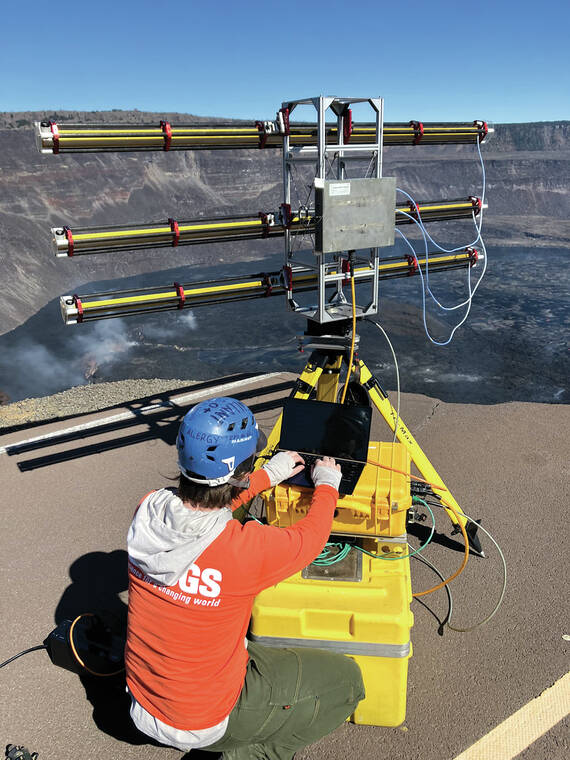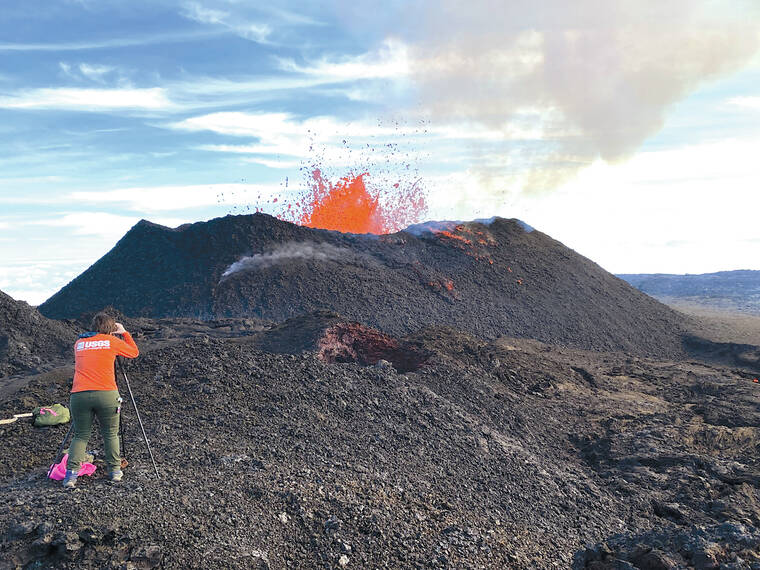Volcano Watch: Aloha to the University of Hawaii’s newest geology professor

Dr. Lis Gallant deploying a terrestrial radar system during the January 2023 eruption of Kilauea. This instrument can detect small-scale changes in the shape of the lake’s surface and calculate the speed at which those changes are occurring. (Courtesy photo/USGS)

Dr. Lis Gallant measuring fountain heights during the 2022 eruption of Mauna Loa using a laser rangefinder. (Courtesy photo/USGS)
Dr. Lis Gallant has spent the last two and a half years at the USGS Hawaiian Volcano Observatory (HVO) as a National Science Foundation Postdoctoral Fellow studying the lava and cinder cones from the 2018 eruption of Kilauea. She is making a short move up the hill this week to join the department of geology at the University of Hawaii Hilo (UHH) as an assistant professor.
Dr. Lis Gallant has spent the last two and a half years at the USGS Hawaiian Volcano Observatory (HVO) as a National Science Foundation Postdoctoral Fellow studying the lava and cinder cones from the 2018 eruption of Kilauea. She is making a short move up the hill this week to join the department of geology at the University of Hawaii Hilo (UHH) as an assistant professor.
Volcanology was not always on the horizon for Lis when she started her academic journey in Troy, New York. She took courses at Hudson Valley Community College before receiving a bachelor’s degree in electronic media, arts and communications from Renssealer Polytechnic Institute. After several years working in the medical software industry, she returned to school and received a second bachelor’s in geology from Buffalo State University.
ADVERTISING
As an undergraduate student Lis conducted research on tephra deposits of Santa Ana Volcano in El Salvador, which helped her discover a passion for science with real-world application. It was after this that Lis first came to the island of Hawaii to work at HVO as an intern mapping lava flows on Mauna Loa and assisting in Pu‘u‘o‘o eruption response from 2012 to 2013.
Lis then went to the University of South Florida (USF) to pursue both a master’s and Ph.D in geoscience. Her work focused on developing new computer-based lava flow hazard assessment tools. Lis also expanded her skill set by working with different kinds of radar to study subtle changes in the shapes of volcanoes and map eruptive deposits below the ground.
In addition to her research, she was an avid teacher while working on her degree, instructing numerous courses and assisting with USF’s summer field courses. She taught students from Florida — many of whom had never seen mountains before — to map folds, faults, and geologic deposits for the first time.
While at USF, Lis was part of the response to volcanic unrest at Nevado del Ruiz in Colombia, and the eruption of Momotombo in Nicaragua. These experiences further bridged the gap between academic research and applied science, which set Lis on her path after she graduated with her PhD.
Thereafter, Lis moved to the United Kingdom in 2020 and joined the IMAGINE project at the University of Cambridge department of geography. Although the COVID-19 pandemic prevented her from traveling to Chile and Argentina to examine the human and environmental geographies in these volcanic regions, she was able to forge strong connections with her colleagues and she looks forward engaging UHH students in this network.
Lis returned to HVO in 2021 and continues to engage in both exciting research and eruption response efforts. She has helped respond to the 2020, 2021 and 2023 eruptions of Kilauea and the 2022 Mauna Loa eruption.
Lis brought several pieces of novel scientific equipment to study the volcanoes, including a magnetometer mounted on an uncrewed aerial vehicle, a ground penetrating radar, and a special radar that can detect rapid changes in the shape of the landscape (a terrestrial radar interferometer, or TRI).
The TRI was deployed during the waning phases of the Mauna Loa eruption. The flow front was difficult to continuously monitor due to inclement weather and logistical constraints of working at high altitude.
Lis and graduate students from USF successfully located the flow front in near-zero visibility conditions and were able to image flow thickening along the margins.
Lis has continued to teach during her time at HVO. She is a faculty member for the GeoSPACE project, a field course that focuses on improving the experiences of disabled students in the geosciences. Her efforts were recently recognized by the International Association for Geoscience Diversity when they presented her with their Inclusive Geoscience Education and Research Award in 2022.
Lis is excited to bring all of these amazing assets — passion for teaching, diversifying the geosciences, and volcano research — to her students as she begins her first semester at UHH. Although we will certainly miss her at HVO, we look forward to collaborating with her as a UHH partner. UHH has been an active partner with HVO for many years and this relationship will continue to thrive with the department of geology’s newest professor.
Please join us sharing our aloha for Dr. Lis Gallant.
Volcano activity updates
Kilauea is not erupting. Its USGS Volcano Alert level is ADVISORY.
Active lava has not been visible within Halema‘uma‘u crater at the summit of Kilauea since June 19. Over the past week, earthquake activity in the summit region remained elevated and summit tiltmeters generally showed inflation. A sulfur dioxide (SO2) emission rate of approximately 86 tonnes per day was measured on Aug. 15.
Mauna Loa is not erupting. Its USGS Volcano Alert Level is at NORMAL.
Webcams show no signs of activity on Mauna Loa. Seismicity remains low.
Summit ground deformation rates indicate slow inflation as magma replenishes the reservoir system following the recent eruption. SO2 emission rates are at background levels.
There were three earthquakes with three or more felt reports in the Hawaiian islands during the past week: a M3.2 earthquake 21 km (13 mi) SW of Laupahoehoe at 29 km (18 mi) depth on Aug. 22 at 6:54 p.m. HST, a M3.4 earthquake 11 km (6 mi) E of Pahala at 32 km (20 mi) depth on Aug. 20 at 12:05 p.m. HST, and a M2.4 earthquake 3 km (1 mi) SSW of Volcano at 2 km (1 mi) depth on Aug. 17 at 2:03 p.m. HST.
HVO continues to closely monitor Kilauea and Mauna Loa.
Please visit HVO’s website for past Volcano Watch articles, Kilauea and Mauna Loa updates, volcano photos, maps, recent earthquake information, and more. Email questions to askHVO@usgs.gov.
Volcano Watch is a weekly article and activity update written by U.S. Geological Survey Hawaiian Volcano Observatory scientists and affiliates.


